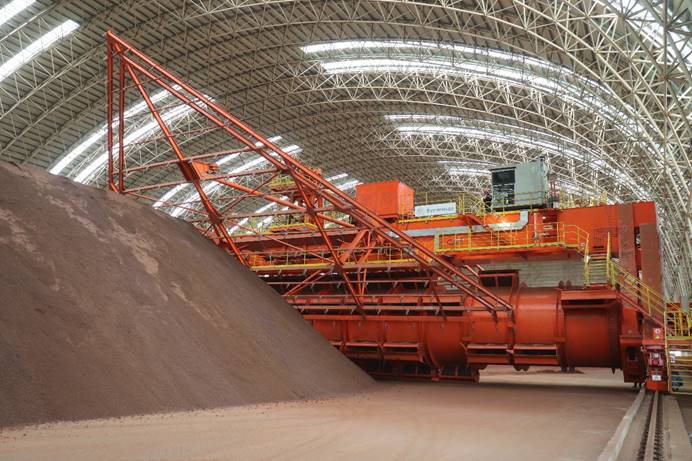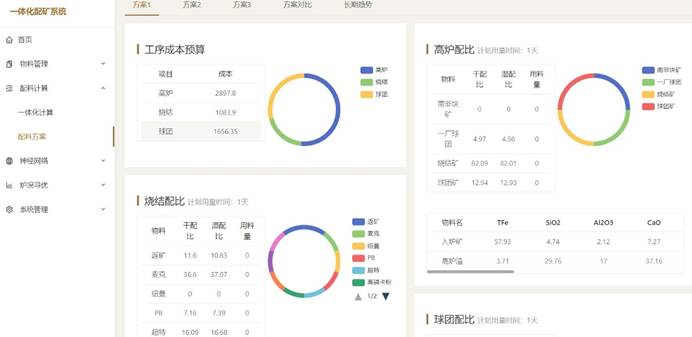Green and smart integrated ore proportioning is now a reality
Date:2022/8/22 Source: CISDI
Background
Despite being a major steel power, China has long been relying on imported ores for its steel production.
Statistics show 80 per cent of its annual ore consumption is imported and reliance on imports prevents China’s steel enterprises from pursuing higher standards and developments.
The situation is even more severe for private steel producers, who have no access to concluding long-term ore supply agreements with large foreign mining companies.
In addition to its insufficient, unstable ore supply, China’s ore proportioning capacity is limited.
But solutions are now being found.
In 2017, China Minmetals kickstarted the move by building an International Ores Trading Centre (including blending and proportioning services) at Caofeidian Port in Tangshan City, which is based in China’s Hebei Province.
Capitalising on the port’s logistical advantages, the centre is now providing highly-efficient, low-carbon ores solutions for steel producers. Services are tailored to the individual needs of a client’s blast furnaces.
CISDI has now undertaken a critical task in the green, intensive ores supply chain - it is leading technological research into the highest-standard ore proportioning sector.
Creating an intelligent integrated ore proportioning solution
Conventional ore processing methods have focussed on the raw material’s composition and its chemical and physical properties, plus prices and operator experience.
But these factors were insufficient to meet production requirements at sintering, pelletising and ironmaking plants where no stable raw material proportioning was available.
Ore supply conditions, plus fluctuating recipes and ore proportions, left these producers with a laborious task.
Individual sections of the conventional proportioning method may save costs, however, the entire system - from ore proportioning to sintering and ironmaking - can result in a total cost increase (calculated on hot metal costs). In addition, the optimisation process is often inefficient. In some cases, systematic total costs rise instead of fall.
Aware of the problems, CISDI’s low-carbon technology institute has combined its research with process, theory, lab and big data-based modelling. The team gathers fine data on single and blended chemical compositions, grains, sintering characteristics, sinter cold-state and metallurgical performances.
As a result, an integrated upstream-ironmaking big data base has been built, featuring a deep-learning optimisation model created from big data intelligent algorithms.
These advanced methods lead to scientific, effective, stable and optimal ore proportioning.

CISDI provided EPC-based services for this drum reclaimer project at the Caofeidian International Ores Trading Centre
In addition, CISDI and China Minmetals Caofeidian Co have built an integrated metallurgical laboratory for raw materials and ironmaking procedures.
By studying the production data and continuously improving the model, the partnership has achieved market-based, customer-preferred ore proportioning solutions.
For the first time, the full process - from ore proportioning to sintering and ironmaking - has been interconnected. Results are outstanding - stable, smooth sintering and ironmaking with remarkable reductions in operating costs.
A blast furnace’s fuel ratio is reduced by 5-10kg per tonne of hot metal and the total costs saved range from US$ 2.2-4.5 per tonne of hot metal.
Features:
- a big data base of raw material performances, set after analysing hundreds of lab testing and onsite production results
- a model set on intelligent algorithm
- an integrated ore proportioning platform, encompassing optimal, trusted expertise, improved cost performance and tailored solutions.

A screenshot of the CISDI-launched integrated, intelligent ores proportioning model
Marked increase in efficiency and costs
CISDI’s team has tapped the potential for marginal ores to be proportioned, which could result in them becoming a cost-effective supplement for main or commonly-used ores. CISDI believes the possibility of proportioning main and marginal ores is worth researching, as it could bring about substantial benefits in costs and quality.
Two standardised proportioned fine products have already been developed - MHBF and WKHY01/04. They are sought after in the Chinese market. Sales to Hebei Iron and Steel Group and Jinxi Steel have already totalled over 4 million tonnes.

CISDI’s ore proportioning team, pictured at a sintering plant
Uniformly-proportioned ores are also being produced by the centre. These ores have a uniform composition and grain size, and their quality is stable. Direct charging for smelting creates great values for steel producers.
In May 2022 the centre signed a long-term supply agreement with Wenfeng Steel in China’s Hebei Province.
Some 500,000 tonnes of the uniformly-proportioned ores have already been delivered to Wenfeng.
Huge improvements in production indicators have been recorded across its sintering and ironmaking, boosting Wenfeng’s drive for greater improvements in quality and cost performance:
- sinter bed as thick as 1,000 millimetres, which is enhancing hourly production capacity, with the smooth, stable operations as a precondition
- blast furnace fuel ratio reduced by 30-plus kilograms per tonne of hot metal.

